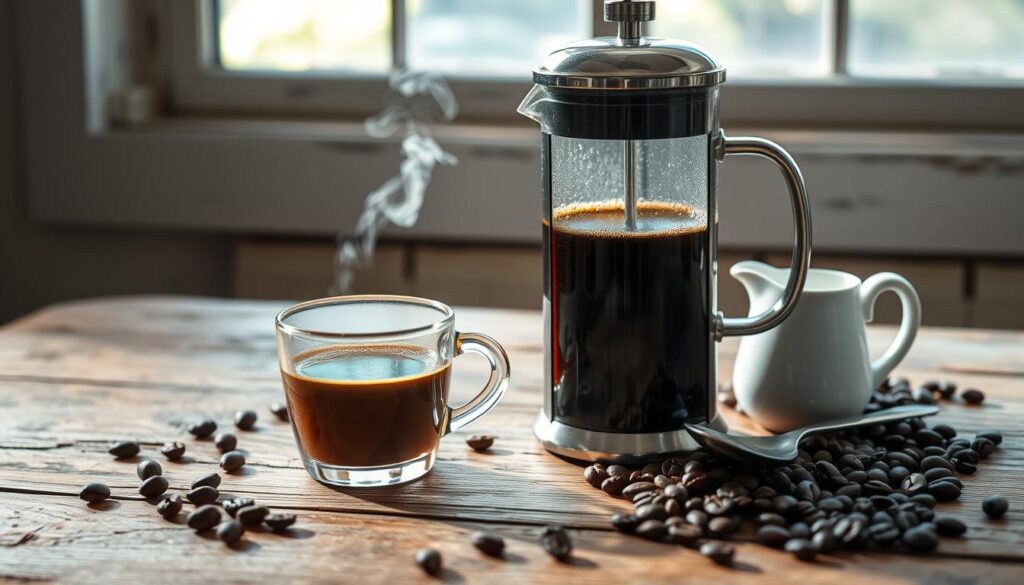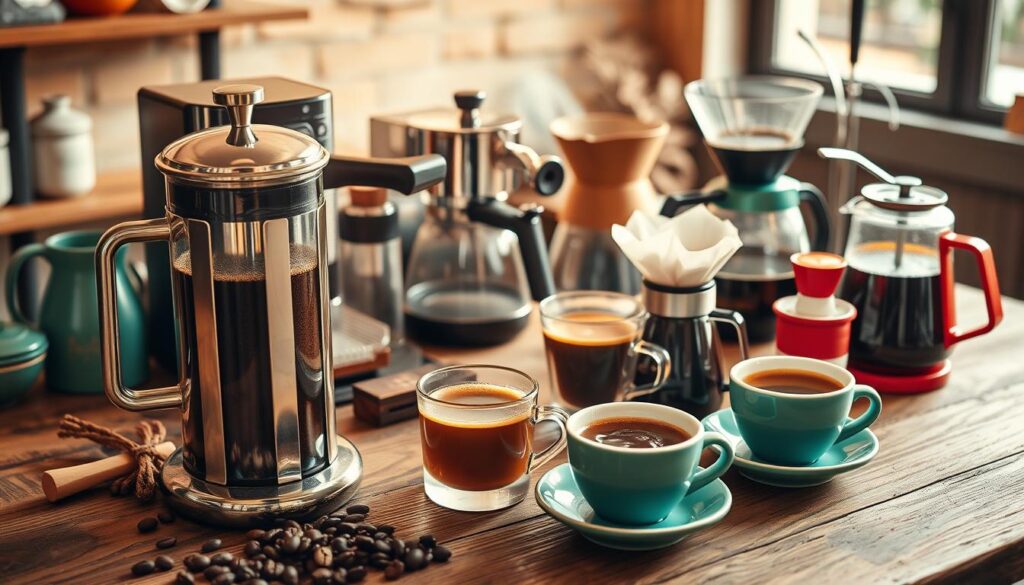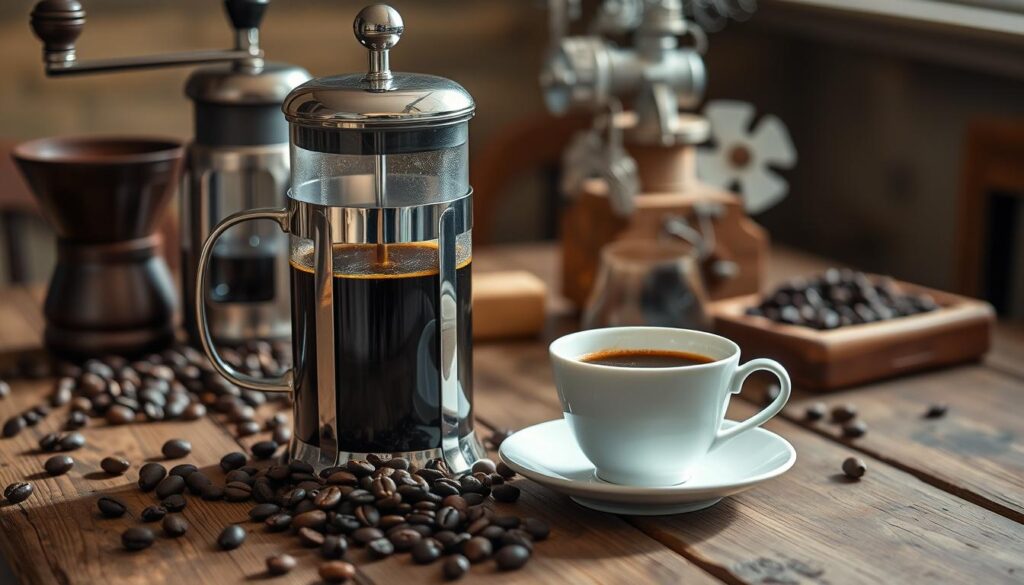This website contains affiliate links. As an Amazon Associate, I earn from qualifying purchases. The content on this website was created with the help of AI.
Unlock the secret to brewing richly flavorful coffee with a French press. This guide explores the best practices and expert tips for using a French press. We’ll cover everything from selecting the right grind size to mastering the ideal coffee-to-water ratio. You’ll learn how to elevate your French press coffee experience.
Key Takeaways
- Discover the optimal grind size for French press brewing
- Master the perfect coffee-to-water ratio for a balanced, full-bodied brew
- Achieve the ideal water temperature for French press coffee
- Learn proven techniques for blooming and steeping the coffee grounds
- Maintain and clean your French press for lasting performance
- Troubleshoot common French press issues, like sediment in the cup
- Explore different coffee varieties that shine in the French press
Introduction to French Press Coffee
The French press, also known as a cafetière or press pot, is a favorite brewing method. It lets coffee lovers control the whole extraction process. This method makes a full-bodied, flavorful cup of coffee with a rich mouthfeel. We’ll look at the best ways and expert tips for using a French press to get delicious coffee every time.
The benefits of French press coffee include a stronger and more concentrated flavor. The brewing process lets the coffee grounds and water stay together longer. This makes a cup with a great balance of sweetness, acidity, and body. Plus, the French press keeps more of the coffee’s natural oils and compounds, making the coffee richer and more satisfying.
The French press brewing process is simple: grind the coffee beans coarsely, add hot water, let it steep, and then press down the plunger. This ensures the coffee’s full flavor is extracted, making a truly remarkable cup of coffee.
“The French press is a game-changer for coffee lovers who want to take control of their brewing experience and savor every sip.”
Whether you’re a coffee expert or just starting, the French press is a great brewing method. It’s versatile and easy to use. With the right techniques and a bit of practice, you’ll be brewing the perfect French press coffee in no time.
Best Practices for using a French Press
To make the perfect cup of coffee with a French press, focus on two important things. First, the grind size of the coffee beans matters a lot. Second, getting the coffee-to-water ratio just right is key. By mastering these, you can bring out the full flavor of your French press coffee.
Choosing the Right Grind Size
The perfect grind size for French press coffee is coarse, like sea salt. This coarse grind helps extract the flavors well without letting the coffee grounds pass through the filter. If the grind is too fine, your coffee might taste muddy and over-extracted. So, it’s very important to get the grind just right.
Mastering the Perfect Coffee-to-Water Ratio
Finding the right coffee-to-water ratio is crucial for a great French press brew. A good starting point is a ratio of 1 to 2 coffee to water. But, you might need to adjust this based on what you like. Start with 2 tablespoons (10 grams) of coarse french press grind size coffee for every 4 ounces (120 milliliters) of water. Then, adjust the ratio to match your taste.
| Coffee | Water | Ratio |
|---|---|---|
| 2 tablespoons (10g) | 4 ounces (120ml) | 1:2 |
Try different french press coffee ratios and coffee to water ratio for french press to find what you like best.
Optimal Water Temperature for French Press Brewing
Brewing the perfect cup of coffee with a French press is more than just the right coffee-to-water ratio. The water temperature is key to unlocking your coffee’s full flavor. The best temperature for French press coffee is between 195°F and 205°F (91°C to 96°C).
This range is perfect for French press brewing. It extracts the right balance of oils, sugars, and acids from the coffee. If the water is too cold, your coffee might taste weak. If it’s too hot, it can taste bitter.
To get the right water temperature, use a gooseneck kettle or a temperature-controlled electric kettle. Boil the water, then wait 30 seconds to a minute before pouring it over the coffee. This pause lets the water cool to the ideal brewing temperature.
| Water Temperature | Brewing Result |
|---|---|
| Below 195°F (91°C) | Underextracted, watered-down brew |
| 195°F to 205°F (91°C to 96°C) | Optimal extraction, rich and full-bodied flavor |
| Above 205°F (96°C) | Over-extracted, bitter and astringent flavor |
By controlling the water temperature, you can make sure your French press coffee is perfect. This way, you get the full flavor of your coffee beans.
French Press Brewing Techniques
Learning to make French press coffee can make your morning better. Focus on two main steps: blooming the coffee and getting the steeping time right.
Blooming the Coffee Grounds
The blooming step is when you pour hot water over the coffee grounds. This lets them expand and release gases. It’s key for even extraction and a balanced taste.
By blooming, you’re getting the grounds ready for the full immersion of French press brewing.
Proper Steeping Time
The best steeping time for French press coffee is 4 to 5 minutes. This lets the coffee’s oils and flavors come out fully. It makes the coffee rich and full-bodied.
Remember to use a timer. Pressing the plunger too early can make the coffee bitter.
By learning these french press brewing techniques, like blooming the coffee grounds in french press and the french press steeping time, you’ll make perfect French press coffee every time.

“The French press is a simple yet powerful tool in the coffee enthusiast’s arsenal. Mastering the techniques of blooming and steeping can unlock a world of rich, flavorful coffee.”
French Press Cleaning and Maintenance
Keeping your French press clean is key to making great coffee. Learning how to clean a french press and french press maintenance will help. This way, your coffee will always taste rich and flavorful.
Disassembling and Cleaning
Take apart your French press after each use. This includes the carafe, plunger, and filter. Rinse each part with warm water, but avoid harsh cleaners that can taint your coffee.
Don’t forget to clean the plunger’s mesh filter. It’s where coffee grounds and oils can build up.
Descaling for Mineral Buildup
Minerals from the water can clog your French press over time. To fix this, descale it by soaking it in a vinegar and water mix. This solution will clear out any mineral buildup, keeping your coffee tasting great.
Proper Storage
Store your French press with the plunger up. This keeps the seal from getting damaged. It ensures your French press works well when you next use it.
| French Press Cleaning Essentials | Frequency |
|---|---|
| Disassembly and Rinsing | After each use |
| Descaling | Every 1-2 months |
| Plunger Storage | In between uses |
By sticking to these how to clean a french press and french press maintenance steps, your French press will always make perfect coffee.
Troubleshooting Common French Press Issues
The French press is known for its rich, flavorful coffee. But, users sometimes face challenges. One big issue is unwanted sediment in the cup.
This problem often comes from the grind size and how you brew. It’s important to find the right balance.
Reducing Sediment in French Press Coffee
To cut down on sediment, use a coarse grind. Fine grinds can make your coffee gritty. Try different grind sizes to find the perfect one.
Also, how you brew matters a lot. Press the plunger slowly and evenly. This lets the grounds settle before you pour.
If sediment is still a problem, try a finer mesh filter or a paper filter. They can make your coffee even cleaner.
- Use a coarse grind size to minimize sediment
- Press the plunger down slowly and gently to allow the grounds to settle
- Try a finer mesh filter or paper filter for an even cleaner cup
By following these french press troubleshooting tips, you can enjoy a smooth, sediment-free french press coffee. It will let you fully enjoy the taste of your favorite beans.
Exploring Different Coffee Varieties for French Press
The French press lets you try many coffee varieties and find new favorites. You can enjoy the bright, fruity notes of East African beans or the rich, chocolatey flavors of Central American blends. The French press brings out the special traits of different coffee origins and roast levels.
When picking best coffee beans for french press, consider these varieties that work great with it:
- Ethiopian Yirgacheffe: Known for its floral aroma and citrus-like acidity, this coffee variety thrives in the French press, showcasing its complex flavor profile.
- Kenyan AA: With its bright, vibrant notes of blackberry and raspberry, Kenyan AA beans are a perfect match for the French press, offering a refreshing and invigorating coffee experience.
- Guatemalan Huehuetenango: The rich, chocolatey undertones of Guatemalan Huehuetenango beans are amplified by the French press, resulting in a smooth and indulgent cup of coffee.
- Sumatra Mandheling: The earthy, full-bodied nature of Sumatra Mandheling beans pairs beautifully with the French press, creating a bold and satisfying cup of coffee.
Try different coffee varieties for french press to find what you like best. The French press lets you explore the unique flavors of various beans and roasts. So, don’t be afraid to try new and exciting coffee varieties.
“The French press is the perfect brewing method for showcasing the unique characteristics of different coffee varieties.”
French Press vs. Other Brewing Methods
The French press is a favorite among coffee lovers, but it’s not the only choice. It’s compared to drip coffee makers, pour-over, and espresso machines. The French press is loved for its full-bodied, flavorful coffee with a rich mouthfeel.
One big plus of the French press is that it extracts more oils and flavor compounds. This makes the coffee taste richer and more intense. In contrast, drip coffee makers give a lighter taste, while pour-over and espresso machines offer different flavors and textures.
| Brewing Method | Flavor Profile | Mouthfeel | Convenience |
|---|---|---|---|
| French Press | Full-bodied, intense | Rich, creamy | Hands-on, time-consuming |
| Drip Coffee Maker | Lighter, more subtle | Smooth, clean | Automatic, convenient |
| Pour-Over | Complex, nuanced | Balanced, smooth | Manual, hands-on |
| Espresso Machine | Intense, concentrated | Thick, syrupy | Specialized, requires skill |
The French press also lets you control the brewing process closely. You can adjust grind sizes, water temperatures, and steeping times. This is great for those who love the art and science of coffee brewing.
Choosing between a French press and other methods depends on what you like. Do you want a bold, full-bodied coffee or a lighter, more nuanced taste? There’s a brewing method for everyone.

Enhancing Your French Press Experience
To make your French press coffee even better, try preheating the carafe and enjoy the full flavor. Preheating the French press with hot water keeps the brewing temperature perfect. This makes your coffee hotter and more flavorful.
Also, let the brewed coffee sit for a few minutes before pouring. This step lets the flavors and aromas fully develop. So, you can get the most flavor from french press coffee.
Preheating the French Press
Begin by filling the French press with hot water. Let it sit for a minute or two to warm up the carafe. This step keeps your coffee at the best temperature, making it richer and more balanced.
Once the carafe is warm, throw out the water and start brewing as usual.
Enjoying the Full Flavor Profile
After steeping, don’t pour the coffee right away. Wait 2-3 minutes to let the flavors fully develop. This way, you get the true complexity of your french press coffee.
When ready, slowly press down the plunger and pour your coffee. Enjoy every sip.
By adding these simple steps to your French press routine, you’ll enjoy a more flavorful coffee. Try different brewing methods to find what you like best.
Conclusion
In this guide, we’ve covered the top tips for making great coffee with a French press. You now know how to pick the right grind and coffee-to-water ratio. You also know how to brew and take care of your French press.
This knowledge lets you make amazing coffee every time. By following these steps, you can make the most of your French press. Enjoy a truly special coffee experience.
This article has given you the best tips for using a French press. Whether you’re new to coffee or a pro, these tips will help you make delicious coffee at home. Dive into the art of French press brewing and enjoy the rich, aromatic flavors it offers.
Keep exploring coffee and remember the French press is very versatile. Try different coffee types, water temperatures, and steeping times. This will help you find the perfect coffee for you. With the knowledge from this guide, you’re ready to become a French press master. Your coffee will impress you and your friends.
This website contains affiliate links. As an Amazon Associate, I earn from qualifying purchases. The content on this website was created with the help of AI.

